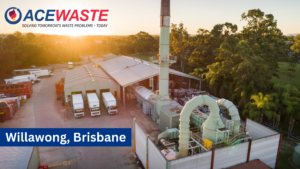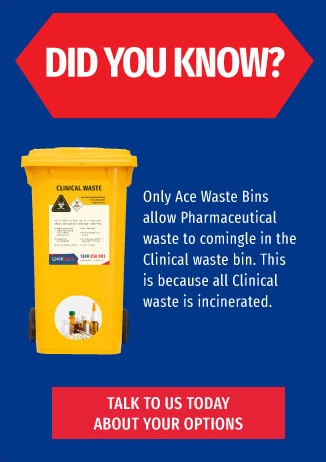Did you know that our Brisbane high-temperature incinerator was the first of its kind in Australia? That’s right! Located in Willawong, QLD, this advanced waste disposal facility was meticulously designed and brought into operation in October 1993 after years of dedicated research and planning.
As an EPA-approved, high-temperature incineration facility, our Brisbane plant set the benchmark for the national waste industry and continues to stay ahead of the curve in sustainable waste solutions for QLD. Continue reading to learn more!

What exactly does an incinerator do?
An incinerator burns waste materials at extremely high temperatures until they are reduced to ash or non-harmful byproducts. As an alternative to landfill, its primary purpose is to dispose of solid waste, hazardous materials, or clinical waste in an environmentally friendly and efficient manner.
Our Brisbane incinerator specs
Our Willawong site utilises an on-site stepped hearth incinerator that operates between 800° Celsius and 1000° Celsius in the primary chamber. Additionally, we have a secondary combustion process at temperatures ranging from 1000° C to 1250° C. This careful and controlled approach ensures the complete destruction of your waste. Any and all pharmaceuticals, pathogens and carcinogens present in medical and related wastes will be obliterated, providing you with the assurance of a thorough waste disposal solution.
Location: 491 Gooderham Road, Willawong, QLD 4110, Australia
Service Areas: Greater Brisbane and Metro, Gold Coast, Sunshine Coast, and Toowoomba
Operating Since: 1993
Capacity: 1500 kg per hour (36 tonnes per day)
Waste Streams: Medical waste (clinical and related waste), pharmaceutical waste, biosecurity (quarantine) waste, solvents, oily rags, cartridges and various other prescribed industrial wastes.
Why is incineration better for the environment than landfill?
Incineration is considered to be a more environmentally beneficial waste management method compared to landfill for several reasons:
- Incineration significantly reduces the volume of waste. The remaining ash and residue take up far less space than the original waste, which helps conserve valuable land resources that landfills would otherwise occupy.
- Ace Waste’s modern incinerators are built with energy recovery systems. The energy generated from combustion of medical and related waste creates a self-sufficient operation, reducing the dependency on fossil fuels. (Heat generated during the incineration process can also be utilised for ancillary power generation, all of which forms part of the Ace Waste 2025 Waste to Energy project).
- Landfills generate a significant amount of methane (CH4), a potent greenhouse gas, 24 times more damaging as a greenhouse gas than CO2. Our Incinerators are built with advanced and strict pollution control technologies to minimise harmful emissions and environmental pollution.
- The high temperatures in the incineration process guarantee the destruction of pathogens and hazardous materials, protecting our environment and communities.
- Incineration eliminates the risk of waste attracting pests and rodents by reducing the total volume of waste by up to 85%, minimising associated health hazards.
How does the incinerator convert waste into energy?
Incineration plants typically rely on natural gas for maintaining combustion. However, our state-of-the-art incineration plants have a unique advantage when dealing with clinical and related waste streams.
These waste streams possess enough inherent energy, mainly due to their high plastic content (around 30%), which enables them to sustain combustion conditions with minimal additional fuel requirements. The rated calorific value (the amount of heat energy present) of clinical waste is 28 MJ/Kg, almost equal to coal (32 MJ/kg energy).
This remarkable characteristic of clinical waste contributes over 90% of the necessary heat energy for maintaining combustion whilst ensuring it’s environmentally sound and permanent destruction. Once the plant is up and running, the only inputs required are clinical and high-value wastes, along with combustion air.
This exceptional method is how we are able to ensure a sustainable and cost-effective solution for your waste disposal requirements.
Achieve the green tick of approval with Ace Waste!
Did you know our dedicated team helps divert over 11,000 tonnes of clinical and related waste from landfills annually? That’s huge!
We have designed our approved incineration process to produce 24 times fewer greenhouse gas emissions than other treatment disposal methods. Additionally, our combustion and pollution control systems are under constant monitoring by the Environmental Protection Agency, ensuring safe operations and environmental compliance.
When you choose Ace Waste to collect, manage and dispose of your waste, you can rest assured that we will treat it in a specialised way that balances safety, security, regulatory compliance, and environmental sustainability.

